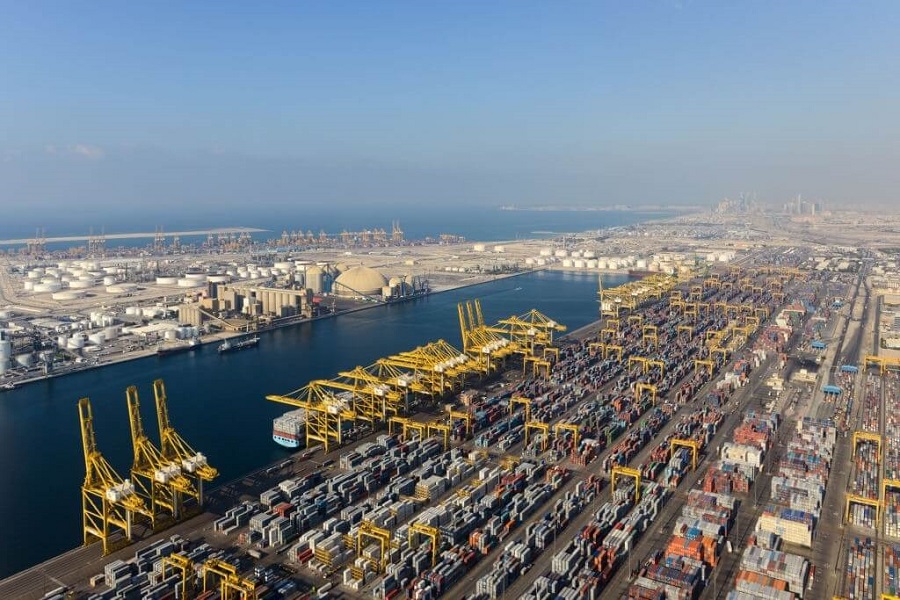UAE Imports and Exports: Statistics | In-Depth Guide
The UAE has been positioned as a hub of international trade between Asia and Europe on an east-west axis, and the CIS and Africa on a north-south axis.
In this guide, we will look at the Economy of the UAE, 7 Emirates, logistic infrastructure, Import and Export in UAE, Top trade partners. Trade barriers, and Trade agreement of UAE.
Table of Contents
The Seven Emirates
Have you ever heard about the monarch or monarchy?
Yes, it is a political system based upon the undivided sovereignty or rule of a single person.
The United Arab Emirates, a monarchical state with a written constitution, works in both republican and absolute monarchical fashion in many ways.
Currently, UAE and Malaysia have a monarchy system, where UAE is actually a federation of 7 monarchial states.
The UAE has These 7 Emirates:
- Abu Dhabi
- Dubai/ Dubay
- Sharjah
- Ajman
- Ras al Khaimah
- Umm Al Quamiam
- Fujairah
Keep reading to learn more about the UAE but first let me tell you about the big state of UAE.
The biggest Emirate is Abu Dhabi, whose Emir has the right of being the President of the council and the country forever.
The United Arab Emirates is a union of 7 Emir (Princes). The Emirs have an organization known as the Federal Supreme Council in which all 7 monarchs meet and discuss Emarati affairs.
Population
First, let’s iron out the basic facts about the population of the UAE.
According to the United Nations (UN), The total population of The United Arab Emirates is 9.99 Million in 2021.
UAE Population According to Years
| Year | Population |
| 2016 | 9.27 million |
| 2017 | 9.40 million |
| 2018 | 9.54 million |
| 2019 | 9.77 million |
| 2020 | 9.89 million |
| 2021 | 9.99 million |
UAE Population by Gender in 2018
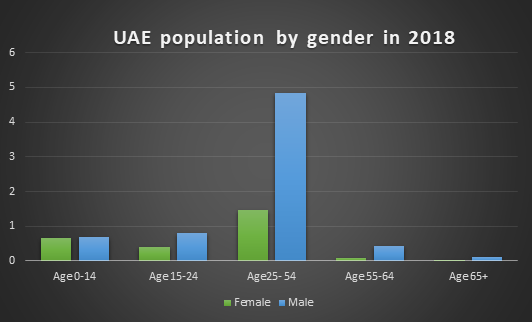
As you may have guessed, the majority of the population falls into the 24-54 age bracket where immigrants and expats make up a large chunk of the UAE’s population.
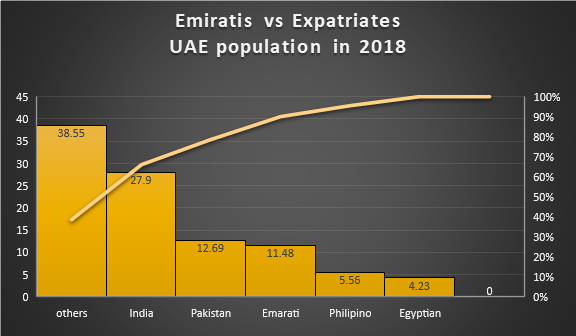
Total Population by Each State in Percentage
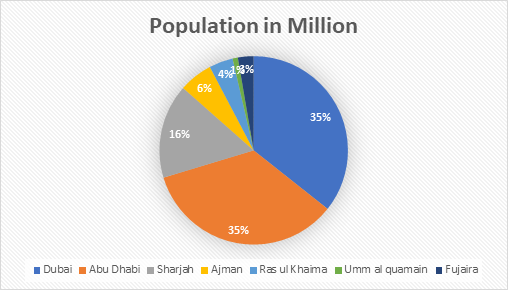
Logistic Infrastructure
And why is this so important?
Because the UAE is ranked 11th in terms of being a logistic-friendly country.
Today, the UAE has become the center of logistics and finance hub in the Middle East.
UAE has emerged as a transshipment hub for Europe-Asia trade with improving process, efficiency, meeting labor shortage, and reducing delivery time. Which makes it a successful logistic industry in the region.
Airports
It seems, the word “Luxury” is specially made for Dubai.
When it comes to the world-class airport, Dubai International Airport is one of the world’s busiest hubs for international passengers.
In 2019, This airport handled 86.4 million passengers and retained its position as the world’s busiest hub for international passengers for the sixth consecutive years.
As we mentioned before, DIA stands first in the list of busiest airports by international passenger traffic, While Abu Dhabi International Airport, the second largest airport in UAE. It has 3 terminal airports (just like DIA) and also has two parallel runways 13R/31L.
Transshipment Ports
When we talk about transshipment ports, the UAE has 12 commercial trading ports. Where the major ports in UAE are:
- Jebel Ali, Dubai
- Mina Rashid, Dubai
- Port Khalifa (AEKHL), Abu Dhabi
- Mina Khalid, Sharjah
- Port of Fujairah, Fujairah
But wait- there’s more, all these ports play a major part in the UAE economy, development, and growth of the country.
Port Jebel Ali, also known as Mina Jebel Ali located in Dubai, is the world’s ninth busiest port in the world.
Let’s take a closer look at it, this port is connected with the Dubai International Airport and the Airport Air Cargo village. It deals with shipment to Asia, the Middle East, Northern Africa, and Europe.
In this port, there are four container terminals, T1, T2, T3, and T4. Where T1 is the busiest terminal with 15 berths, 51 cranes, and 9 million TEU capacity. On the other hand, T2 can hold 6.5 million TEUs with 32 crans and 8 berths.
Impressive, right?
Now let’s talk about the ease of doing business index.
Ease of Doing Business Index
The ease of doing business index is based on how the regulatory environment is conducive to business operation and stronger protection of property rights.
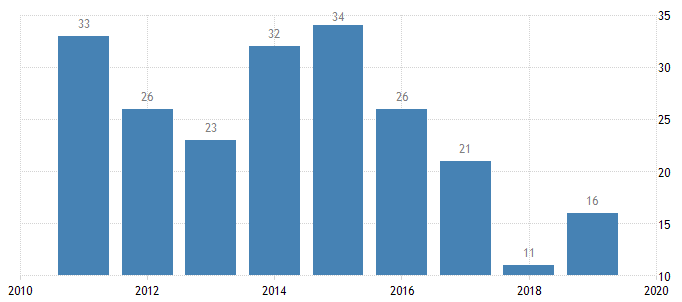
In 2019, the United Arab Emirates stood 16th with 80.9 scores among 190 economies in the ease of doing business.
Ranking on Doing Business Topics- United Arab Emirate
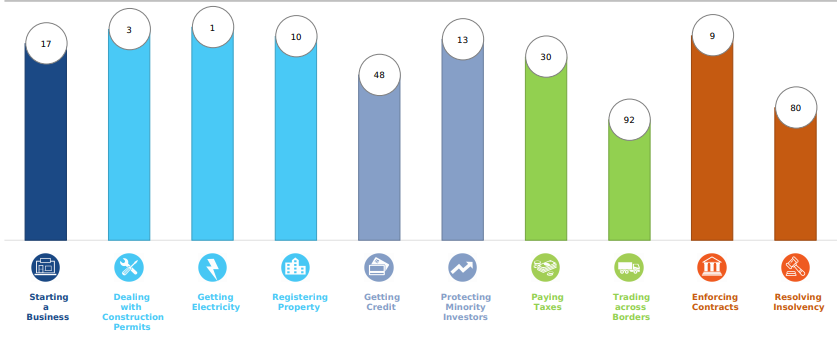
Ranking and Score of starting a Business in UAE and Comparator Economies. DB 2020- Starting a Business Scores

As we can see, in the above ranking of economies on the ease of starting a business is determined by sorting their scores for starting a business. These scores are the simple average of the scores for each of the component indicators.
United Arab Emirate Economy at a Glance
I’d like to share some interesting facts about the UAE economy.
In the 2021 Index of Economic Freedom, the UAE ranked 14th overall 76.9 scores and ranked 1st among 14 countries in the Middle East and North Africa. While It ranked the 28th largest economy in the world with a GDP of 414billion US dollars per capita of $43,005.
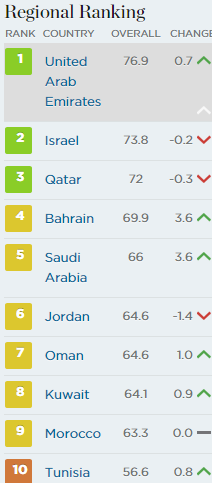
2021 Index of Economic freedom score
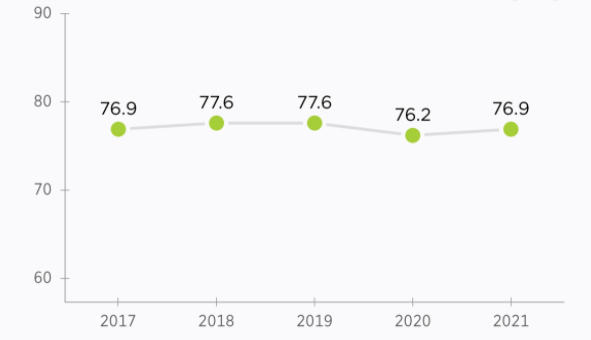
UAE ranked 1st among the Middle East and North Africa countries and economic freedom score is 76.9 overall
So, now you might be asking yourself that UAE is the oil-producing country so what rank does it have in oil production?
UAE ranked sixth in the world in terms of oil production.
Yes, you read it right.
The UAE’s economy is fueled largely by natural gas, petroleum, and other liquids.
Primary energy consumption in the UAE-2018
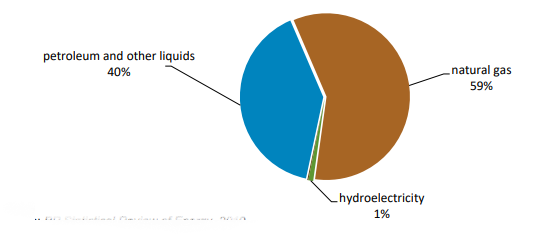
In 2019, the UAE was the third-largest petroleum producer in OPEC behind Saudia Arabia and Iraq. The UAE is both a major exporter and consumer of petroleum liquids.
In 2019, the country produced an average of 4.0 million barrels per day of petroleum and other liquids, the seventh-highest total in the world.
Check this out, the UAE has four refining facilities the largest of which is the Ruwais facilities with 817,000 b/d refining capacity.
UAE’s Refineries, According to the organization of the petroleum exporting countries, Annual Statistical bulletin -2019
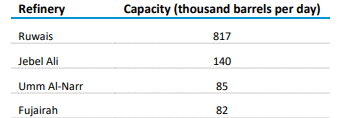
UAE’s Refineries, According to the organization of the petroleum exporting countries, Annual Statistical bulletin -2019
Hold on, we didn’t finish yet, the UAE holds the seventh-largest proved reserves of Natural gas in the world at 215 Trillion Cubic Feet (TCF). And they hope to further boost production to help and meet the country’s growing demand.
UAE Dry Natural gas Production and Consumption (TCF)
(Preliminary estimates for 2018 data)
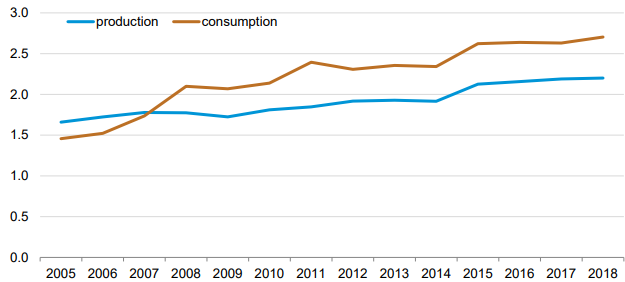
According to the US Energy Information Administration, International Energy Statistical: “ Dry Natural gas production in the UAE rose to 2.2 TCF in 2018. Natural gas consumption in the UAE reached a record high of more than 2.7 Billion Cubic Feet (BCF).”
UAE Import and Export: Component and Statistic
Now to be clear, before we get into this you should know. The United Arab Emirates is one of the world’s top 20 largest exporters and importers of commodities and the largest trading nation of the Middle East.
The UAE continues to grow its imports and exports capabilities, firmly positioning itself as a global logistic hub.
Additionally, UAE exported approx. 238 billion US dollars worth of goods and 72.5 billion US dollars of services in 2019. Although, UAE imported approx.267.9 billion US dollars worth of goods and 72.7 billion US dollars worth of services in 2019.
According to the IMF, the volume of exports of goods and services decreased by -11.9 percent in 2020 as compared to 2019. While the volume of imports decreased by -13.1 percent.
UAE Crude Oil exports by region- 2019
(US Energy Information Administration)

Most of the UAE’s petroleum imports are residual fuel oil with limited imports of motor gasoline and diesel fuel.
Now it’s time to share some key facts about the UAE economy, here they are:
Key Facts of UAE
In 2019, UAE was the world’s biggest importer of Aluminium oxide( $2.12B).
- The UAE secured a second FSRU-based import terminal in Abu Dhabi and has been operational since September 2016.
- UAE exported a total of $248billion and made it the number 24 exporter in the world. Its main export is crude petroleum.
- The Economic Complexity Index(ECI) stated: “ The imports of the United Arab Emirates changed by -$5.4B from $241B in 2014 to $235B in 2019 during the last five reported years.
- UAE was number 22 in total import in 2019. The top imports of UAE are gold, Broadcasting equipment, jewelry, refined petroleum, and diamonds mostly come from China.
The Top Import and Export Commodities in UAE- 2020
| Imports | Exports |
| Gold ($27.3 B) | Crude Petroleum ( $58.1 B) |
| Broadcasting Equipment ($15.5 B) | Refined Petroleum ( $15.4B) |
| Jewelry ($13.4 B) | Gold ( $15.4 B) |
| Refined Petroleum ( $12.8 B) | Jewelry ( $12.2B) |
| Cars ( $11.3 B) | Broadcasting Equipment ( $9.99B) |
| Diamonds ( $11.1 B) | Cars ( $7.87B) |
| Crude Petroleum ($3.48 B) | Petroleum Gas ( $6.51 B) |
Today, the UAE remains a vital re-export point between East and West, It’s strategic location continues to serve its imports, exports, and re-exports industry on an increasingly large scale.
Top Trade Partners of UAE
Besides the facts but China remains UAE’s largest trading partner and Saudia Arabia still maintained its position as the largest Arab Trade Partner.
Following is the list of top trade partners of UAE in 2020.
- China
- India
- USA
- Switzerland
- Saudia Arabia
“We are working on a virtual trade zone, the first of its kind in the world, which will considerably boost the development of e-Commerce regionally and globally. All our achievements will also enable us to host an exceptional EXPO2020 and accelerate our growth and progress beyond the event.” - Sheikh Hamdan Bin Mohammad Bin Rashid Al Maktoum (Crown Prince of Dubai and Chairman of Dubai Executive Council)
UAE’s Major Trade Partners- 2019
| Export | Import | Re-export |
| India (10.8%) | Bahrain (51.3%) | Saudia Arabia (11.1%) |
| Japan (9.67%) | Vietnam (41.7%) | Iran (8.0%) |
| Saudia Arabia (7.22%) | Singapore (22.2%) | Iraq (7.5%) |
| Switzerland (6.09%) | Hongkong (20.5%) | India (6.8%) |
| China (5.92%) | Saudia Arabia (6.96%) | Switzerland(6.2%) |
| Iraq (5.54%) | China (5.06%) | Hongkong (4.9%) |
As we noticed above, The Asian region is the main supplier of UAE trade, and re-exports are distributed to 202 customs territories.
In 2019, UAE’s exports rose by 23 percent, re-exports grew by 4 percent, and imports increased by 3 percent. Foreign trade volume also grew by 22 percent.
Tariff-related Trade Barriers of UAE
So, the question then becomes why do countries impose trade barriers?
The reason is, each country has its own list of items permitted, restricted, and prohibited to import and export. Prohibited goods are any goods the import or export of which is prohibited under the provisions of the Common Customs LawWhereas the restricted goods are those goods the import or export of which is restricted under the provisions of the Common Customs Law or any other regulation or law applicable in the State and may only be released subject to the approval of the competent authority.
Following are the list of Prohibited and Restricted items in the UAE
| Prohibited Items | Restricted items |
| All kinds of narcotic drugs | Pets and domestic animals |
| Gambling tools, machinery, and devices | Arms, ammunition, explosives, and fireworks |
| Nylon fishing nets | Pharmaceutical products & Surgical Instruments |
| Live swine | Print materials, publications, and media products |
| Used, reconditioned, and inlaid tires | Nuclear energy-related products |
| Radiation and nuclear fallout contaminated substances | E-cigarettes and electronic hookah |
| Items that contradict Islamic faith and public morals | Transmitters and radio equipment |
| Paan and betel leaves | Alcoholic beverages |
| Rough diamonds |
Import Clearance Procedure in UAE
In UAE, to clear the customs of import shipment arrived at seaport or airport, you need to require all these following documents:
- Bill of lading (sea channel)/ Airway Bill (air channel)
- Commercial Invoice
- Packaging list
- Certificate of origin
- Delivery order
Export Clearance Procedure in UAE
For export shipment for seaport or airport in UAE required documents are:
- Export Invoice
- Packaging List
Federal Customs Authority (FCA) draws the customs policies in UAE for each emirate in compliance with the common custom law.
Trade Agreement of UAE
So, most of you already know what a trade agreement is.
The thing is, the UAE is a party to several multilateral and bilateral trade agreements, including with partner countries in the GCC. Under the Greater Arab Free Trade Area Agreement (GAFTA), the UAE has free trade across to Saudia Arabia, Kuwait, Bahrain, Qatar, Oman, Jordan, Egypt, Iraq, Lebanon, Morocco, Tunisia, Palestine, Syria, Libya, and Yemen.
According to the UAE Federal Customs Authority (FCA), the UAE signed agreements with the following countries as well:
- Islamic Republic of Pakistan (2007)
- Republic of Algeria (2011)
- Republic of Azerbaijan (2011)
- Republic of India (2012)
- Republic of Kazakhstan (2012)
- Republic of Argentina (2013)
- Republic of Armenia (2013)
- Republic of Maldives (2014)
- Republic of South Korea (2015)
- Kingdom of Netherland (2015)
Furthermore, the UAE has signed a Free Trade Agreement with Singapore and Newzealand. It has also entered into several agreements on the protection, promotion of investment, and the prevention of double taxation.
The UAE became a Contracting party to the General Agreement on Tariffs and Trade in 1994, and subsequently became a member of the World Trade Organization (WTO) in April of 1996.
The end of the story is, the Gulf states see opportunities for trade more in near future. The UAE is emphasizing its vision and they are promoting science, technology, and innovation and building a strong regulatory framework of key economic sectors.
The UAE is well on track to record robust growth in 2021 as per various economic indicators.
